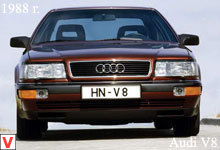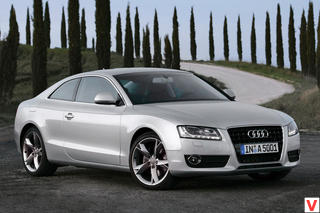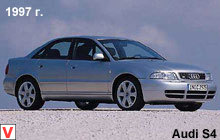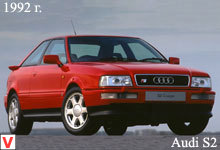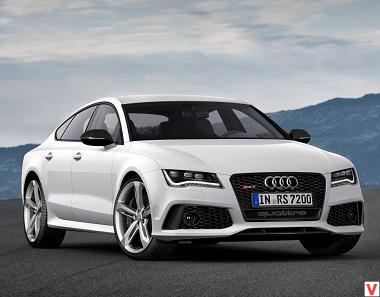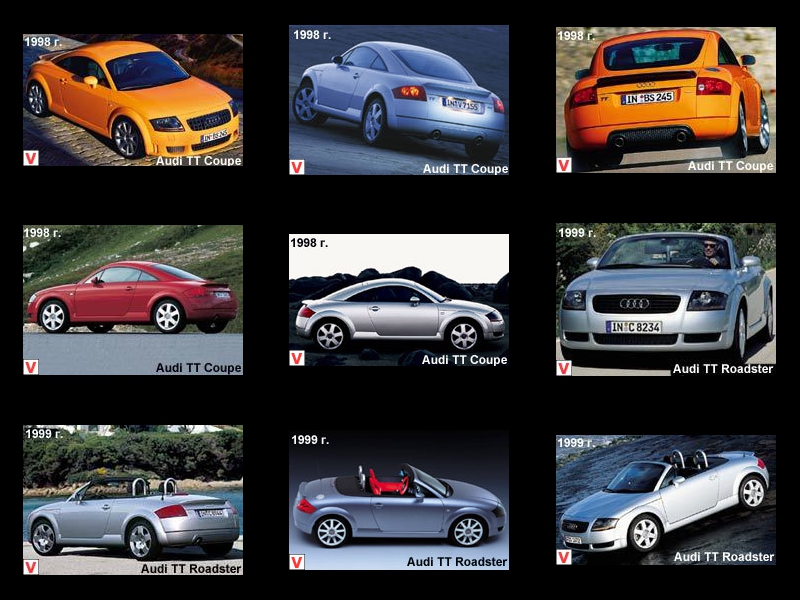
Audi TT - a classic sports front or all-wheel drive car of modern design: a coupe and a convertible (roadster). The prototype of the model was presented in 1995 at the Frankfurt-am-Main Motor Show, the Audi TT coupe model itself was first introduced in Geneva in September 1998, with the roadster body in August 1999. The TT abbreviation is the name of the annual race - Tourist Trophy, which has been held on the Isle of Man in the UK since 1905. The car is built on the platform of the Volkswagen Golf IV.
The very idea of creating this beauty belongs to Freeman Thomas, the same designer, who “had a hand” to create a new Volkswagen Beetle, and who now moved from Volkswagen-Audi to DaimlerChrysler. The design of the Audi TT model is made in a classic sporty style. The cleanliness of the lines and the simplicity of the shapes, the pretty tinted headlights - the eyes, the low fit, nothing like a silhouette - this is the Audi TT Coupe. The car is small (4.04 m), two-door, four-seater. The back and front of the body are similar in shape.

The eye-catching stylistic elements of the car are huge, protruding even behind the inflated wheel arches of 205/55 R15 tires, 17-inch “artillery ” wheels and chrome-plated exhaust pipes integrated into the rear bumper. In general, the car looks very aggressive and at the same time elegant. Several options for painting the body, each of which gives it different features.
Red makes it brighter, more aggressive, makes you give way. Black also gives the TT a threatening look, but this color suits it least of all, not combining with the concept of the car. Calm dark blue ennobles. But the perfect TT color is silver. Even if you do not take into account the fact that in any color the gas cap remains silver and stands out with a bright spot on a different color. The interior of the TT is distinguished by thoughtfulness and convenience, and with all its appearance adjusts the owner to the sporting way.
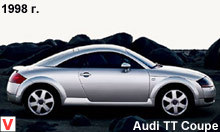
And everything begins with the doors: opening them open, you will first of all see a very broad threshold. Thanks to the wide doors, getting inside is unexpectedly simple. Front seats are extremely ergonomic and will suit a person of any build. Recently TT Coupe won a prize for the most orthopedic front seats. Besides the fact that it is sports seats, their "highlight" is also in a special roller for the lower back.
Seats with a combined upholstery (leather and alcantara) with a full set of adjustments and an adjustable steering column allow you to stay in the workplace quite comfortably. If you order interior design, and not buy "ready", you will be offered a lot of options - from leather or fabric. The rear seat is made only for children or for beauty - an adult person there is not very comfortable. But the luggage compartment volume of 270 liters was pleasantly surprised.
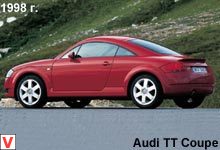
If necessary, the rear seats fold, forming a flat surface and increasing the net volume. It is noteworthy that the boot lid opens with the rear window. In the interior trim polished metal was used generously - from the steering wheel to the door handles. On the dashboard in the same aluminum frame located a huge speedometer and tachometer. Four air deflector shafts, also aluminum, are aimed at the driver and passenger. Semi-rigid plastic is perfectly combined with leather and polished aluminum, and classic - with modern. The attribute of true sports cars looks impressive - a metal stand for the driver’s left foot.
All this creates a unique sports atmosphere. The main design element of the cabin, which also exists outside - on the gas tank lid - metal rings with small grooves (on large devices) or dots (on small ones). They are on everything from the steering wheel, where such a ring in the middle surrounds the traditional Audi rings, and ends with the gearshift lever, where it surrounds the gearshift pattern. These rings are quite functional parts - for example, on fans they regulate the strength of the air flow. Torpedo reminds the control panel of a small aircraft, there is not a single extra line or part, and the only decoration is the aluminum edging of all the round elements.
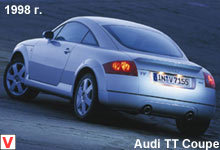
Round in the TT, by the way, is almost everything that can be done so. Even perforated rubber-foot pedals - and those with rounded edges. The car is equipped with a climate control system, located so that it is convenient to control both the passenger and the driver, the audio system (depending on the equipment level: a radio receiver and various tape recorders or a CD player) and other additional equipment. The audio system is closed - so that no one would guess what is inside - a retractable metal socket with two letters - TT. The tiny glass opening levers located near the door handles are right at hand and very sensitive.
Below, in front of the gearbox, under the sliding panel, there are buttons for opening the gas tank and trunk. On the other side of the gearbox are the door lock buttons. All the buttons have pictures that will be understandable even to children, and you don’t have to study the instructions for a week to learn how to use them. Probably, it is not even worth mentioning such trifles as a mirror with lights on the sun protection above the right-hand chair, pleasant night illumination of the devices in red, extremely convenient seat position adjusters.
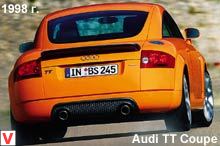
In winter or in the early dank morning, turning on the seat heating button (with 8 positions of the temperature regulator), you will feel not in a cold cold car, but in your favorite chair at home by the fireplace. All readings of the onboard computer are right in front of the driver, and he does not have to take his eyes off the road for more than a fraction of a second to see the fuel consumption, average speed, travel time, temperature behind, and other figures. In winter or in the early dank morning, turning on the seat heating button (with 8 positions of the temperature regulator), you will feel not in a cold cold car, but in your favorite chair at home by the fireplace.
All readings of the onboard computer are right in front of the driver, and he does not have to take his eyes off the road for more than a fraction of a second to see the fuel consumption, average speed, travel time, temperature behind, and other figures. In winter or in the early dank morning, turning on the seat heating button (with 8 positions of the temperature regulator), you will feel not in a cold cold car, but in your favorite chair at home by the fireplace.
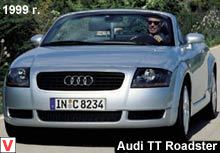
All readings of the onboard computer are right in front of the driver, and he does not have to take his eyes off the road for more than a fraction of a second to see the fuel consumption, average speed, travel time, temperature behind, and other figures. Special attention is paid to safety: a reinforced windshield frame, safety arches behind the seat backs, two airbags, ABS also is included in the obligatory package, combined on front-wheel-drive models with the anti-skid system to be deactivated. Three engine options are available with a displacement of 1.8 liters, front-wheel drive or all-wheel drive.
Modification with front-wheel drive is equipped with the weakest of the 4-cylinder in-line engines, power - 150 liters. from. The maximum speed with a 5-speed manual transmission is 217 km / h. All-wheel drive versions of the Audi TT are equipped with 180- and 225-strong engine versions.
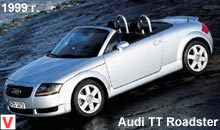
Engine capacity of 180 liters. from. It has high torque (235 Nm in the range of 1950-4700 rpm) and accelerates the car to a maximum speed of 225 km / h. With an engine capacity of 225 liters. from. and a torque of 280 Nm at 5500 rpm, the car accelerates to a speed of 243 km / h. The 225-horsepower engine is aggregated exclusively with a 6-speed gearbox in an all-wheel drive transmission.
The concept of the second generation Audi TT was presented at the Tokyo Motor Show in 2005, and in April 2006 the production version of the Audi TT Mk2 (internal designation Typ 8J) was ready, the first copies of which were released in August of the same year. The new TT Roadster was introduced in March 2007. The car is built on the platform of the Volkswagen Group A5 (PQ35). As in the previous generation, the model is offered in the body of a coupe with a landing formula of 2 + 2, as well as a two-seat roadster. In appearance, the car has become more aggressive. He added 137 mm in length, 78 mm - in width and was 6 mm higher than its predecessor. But at the same time almost 100 kg lighter.

The coupe owes its "lightness" to aluminum: it accounts for 69% of the body weight. Although the rear, doors and trunk lid are still steel. Aluminum elements are made in different ways - and by stamping, and casting, and extrusion.
The list of technologies used in body assembly is impressive: here aluminum-aluminum laser welding, gas-shielded welding, and the first mount used in mass production of automobiles using special screws, which are “welded” to metal when twisted. The drag coefficient decreased from 0.34 to 0.3, and most importantly, the lifting force decreased. The rear spoiler is extended by an electric motor upon reaching 120 km / h and is removed when the speed drops below 80 km / h. Manual spoiler position control is also available via a switch on the instrument panel. The roadster is equipped with a soft electro-hydraulic roof that folds up at the touch of a button.
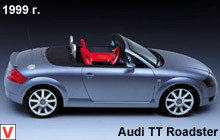
It has a rear window, and the roof itself is made of thick fabric to reduce noise. By pressing another button, you can open the wind shield behind the driver to reduce aerodynamic instability when the roof is folded. The roof folds over the beam of active protection against overturning and is closed with a plastic cover that protects it from the effects of the elements. Very neat, simple - and it does not reduce the useful volume of the trunk.
By increasing the wheelbase by 46 mm, Audi managed to make the second-generation saloon much more spacious. The decoration used only the highest quality materials - soft-touch plastic perfectly combines with leather and polished aluminum. Above the windshield no longer hangs the ceiling. The console is now facing the driver. The ranges of seat and steering adjustments are the broadest. The steering wheel is adjustable both in tilt angle and in flight, allowing you to make the settings even more accurate to ensure comfort.
The layout of the instrument panel is made traditionally. The central display is monochrome. On the screen of the onboard computer, you can now display the digital speedometer. Visibility is good, however, in the coupe version, three-quarters of the view through the rear window is still obscured by stylish, but too long, sloping rear struts.
Originally offered only gasoline engines. The 2.0 TFSI engine has 200 hp variants. (147 kW) and 211 hp (155 kW) From the previous generation got a 3.2-liter V6 with a capacity of 250 hp. (184 kW). In the spring of 2008, a 1.8-liter four-cylinder engine with a capacity of 160 hp was presented. (118 kW) with turbocharging and direct fuel injection technology - TFSI.
All engines were standardized with six-speed mechanics, and as an option was offered the "robot" S Tronic (except for the 1.8-liter engine). The quattro all-wheel drive system is equipped with a Haldex center axle clutch and was available with all engines except the 1.8 TFSI. In 2008, at the Geneva Motor Show, Audi introduced the first diesel engine for the TT version on the European market - the 2.0 TDI quattro.
This engine is paired with a six-speed manual gearbox in the coupe and roadster. The motor is equipped with a common rail system with piezoelectric injectors and produces 170 hp. (125 kW) at 4200 rpm. Acceleration to 100 km / h with a turbo diesel takes 7.5 seconds (coupe), and the average consumption is at the level of 5.3 liters per 100 km. On the second generation Audi TT, a multi-link fully independent rear suspension is installed in addition to the independent front. In addition, as an option, a new active suspension is available - “Audi Magnetic Ride” in which magnetic rheological dampers are used.
The electronic control unit of the suspension automatically adjusts the damping properties depending on road conditions. The car is equipped with almost every possible means of security: airbags with a two-stage opening for the driver and passenger, airbags in the front seats to protect passengers sitting in the back, Isofix child seat anchorage points, daytime running lights, and the pedals are automatically removed from under the feet in case of a head-on collision.
The roadster has acquired an even greater system of connections on the sides and around the windshield, which allows not only to ensure safety in a collision, but also makes the car 120% tougher than its predecessor, thanks to which it became even easier to make turns. The basic coupe version offers seventeen-inch light-alloy wheels, a six-speed manual gearbox, a three-spoke flat steering wheel with leather trim, a 140-watt audio system capable of playing and MP3 files, including dual exhaust pipes, leather upholstery, sports seats and electronic climate control.
In 2008, at the North American International Auto Show in Detroit, Audi introduced the first S-version of the Audi TT - the Audi TTS. The appearance of the TTS has some changes compared to the standard model - a modified front with large air intakes, a redesigned rear bumper with a four-pipe exhaust system. The two-liter 2.0 TFSI engine was seriously reworked - they changed the cylinder block, cylinder head and fuel injectors. Together with other changes, this engine began to give out power in 272 hp (200 kW) and creates a torque of 350 Nm in the range from 2500 to 5000 rpm. Audi TTS is available with a manual or six-speed "robot" S Tronic.
And also, like all "S" models, it is only available with all-wheel drive quattro as standard. The official data on the implementation of the sprint from zero to 100 kilometers per hour for the TTS coupe is 5.4 seconds, and for the roadster - 5.6 seconds. The TTS suspension is underestimated by 10 mm compared to standard models and includes Audi Magnetic Ride system, electronic stability control (ESP), 18-inch wheels in the base. In 2009, the Audi TT RS was presented to the public at the Geneva Motor Show. The car is available in the coupe and roadster. Under the hood of this version is a 2.5-liter five-cylinder turbocharged engine with a TFSI system, which has a rated power of 340 hp.
(250 kW) in the range from 5400 to 6700 revolutions per minute and torque of 450 Nm (at 1,600-5,300 revolutions per minute). The Audi TT RS was fitted with a six-speed manual gearbox, quattro four-wheel drive, which uses a specially adapted Haldex multi-plate clutch and modified rear axle differentials that can cope with torque from a five-cylinder turbo engine. Acceleration of the TT RS coupe up to 100 km / h is 4.5 seconds (4.7 seconds for the roadster), while the maximum speed is electronically limited to 250 km / hour. There is a factory de-limiter option that raises the bar to a maximum speed of 280 km / h.
The coupe has a curb weight of 1450 kg, and the roadster weighs 1510 kg. Like the TTS, the TT RS version has a 10 mm lower ground clearance, the Audi Magnetic Ride system and standard 18-inch wheels with 245/45 ZR18 tires. Rear spoiler is installed as standard fixed (retractable optional). The interior is black with Alcantara sports seats / leather. Recaro armchairs are available as an option.
The Audi TT RS is fully assembled at the Audi plant in Gyor (Hungary) along with the civilian versions of the Audi TT. In 2010, Audi showed restyled models TT Coupe and Roadster. The changes affected the front bumper, air intakes, grille, LED "daylight" lights, increased diffusers and exhaust pipes. The distinctive features of the TTS version are the falshradiator grille and air intakes with double horizontal slats, as well as an exhaust system with four trunks. In addition, the TT Coupe and TT Roadster slightly increased in length - about two centimeters. In addition, new body colors have been added to the car paint palette.
The main changes are technical. The gamma of power units was supplemented with a new four-cylinder 2.0 TFSI engine with turbocharging and direct fuel injection with a capacity of 211 hp. This engine immediately replaced two two-liter 200-strong “four” engines (280 N • m) and a 250-strong “six” with a volume of 3.2 liters (320 N • m). The turbo diesel 2.0 TDI of the second generation (170 hp, 350 N • m) has a reduced weight by four kilograms (up to 154 kg), modernized by the fuel injection system and an oil pump. All this did not increase the return, but had a positive effect on efficiency: in the combined cycle, the TT 2.0 TDI began to consume 5.3 l / 100 km instead of the previous 5.5 l.
In addition to the mechanical box, the TT RS version received a seven-step S tronic “robot” with two “wet” clutches.
